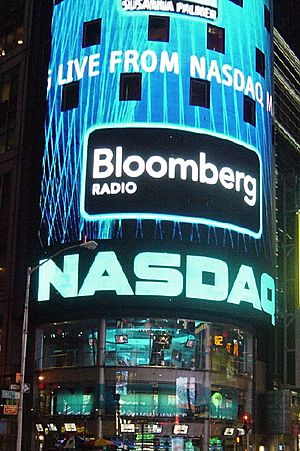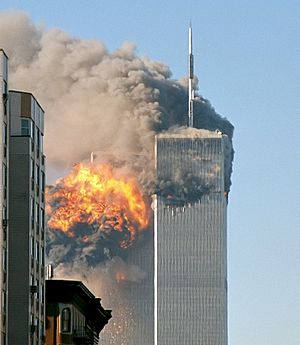History of New York City (1978–present) facts for kids
New York City has gone through many changes since the 1980s. It saw times of growth and challenges. Crime rates went up and then down a lot. Many new people moved to the city, making its population grow past eight million. The terrible September 11 attacks on the World Trade Center in 2001 deeply affected the city.
Contents
New York City in the 1980s and Early 1990s
Mayors Koch and Dinkins Lead the City
The 1980s brought some hope to New York City. The financial world of Wall Street was doing well. This helped the real estate market grow. More people found jobs, and unemployment went down. Mayor Ed Koch worked hard to balance the city's budget. This helped the city get back on track financially by 1981.
However, New York City still had problems with crime and disorder. Mayor Koch often spoke about these issues. He focused on making neighborhoods and city buildings better. This led to some areas improving. New businesses opened, and old apartments became new homes. These changes attracted young professionals to the city.
A big challenge in the 1980s was homelessness. This problem grew during Mayor Koch's time in office. In 1986, the city passed a law against discrimination towards gay and lesbian people. This law covered things like jobs and housing.
In 1989, David Dinkins became the city's first African-American mayor. He won against Rudolph Giuliani. Crime started to go down in 1990 during Dinkins' time. But the city faced other problems. There were racial tensions, like the Crown Heights Riot in 1991. The economy was also very weak. By 1993, many people were out of work. Some people on Staten Island even wanted to leave New York City.
The 1993 World Trade Center Bombing
On February 26, 1993, a bomb exploded in the basement garage of World Trade Center Tower One. The bomb was very powerful. It was meant to make both towers fall down. Luckily, it did not succeed. But six people died, and over a thousand were hurt.
Later in 1993, David Dinkins lost his bid for reelection. Rudolph Giuliani became the new mayor.
New York City Under Mayor Giuliani (1994–2001)


In the mid-to-late 1990s, New York City bounced back. The national economy was growing. The Wall Street stock market was booming. Crime rates also dropped a lot. Mayor Rudolph Giuliani is often given credit for these improvements. He helped make Times Square better. He also worked to make the city safer by fighting crime.
New York City became known as a top "global city." This was because of its great transportation and communication systems. Its large population also helped. The city's image changed from an old, struggling place to a leading world center.
Sports Highlights in the 1990s
The 1990s were a big time for sports in the city. In 1994, the New York Rangers won their first Stanley Cup since 1940. At the same time, the New York Knicks made it to the NBA Finals. They lost to the Houston Rockets in a close seven-game series.
The Knicks reached the NBA Finals again in 1999. They lost to the San Antonio Spurs. The New York Yankees had an amazing run. Led by manager Joe Torre, they won the World Series in 1996, 1998, 1999, and 2000.
The September 11, 2001 Attacks

On September 11, 2001, a terrible event happened. Terrorists took over two passenger airplanes. They crashed them into the two 110-story World Trade Center towers. The planes were full of jet fuel for long flights. The crashes caused huge damage and started big fires. Both towers collapsed in less than two hours.
At the same time, another plane hit the Pentagon in Virginia. A fourth plane crashed in Pennsylvania. In total, 2,977 people died in these attacks.
The 9/11 attacks had a huge impact on New York City. Many businesses moved out of Lower Manhattan for a while. The city lost many jobs and a lot of money. The U.S. government gave billions of dollars to help New York City recover.
The collapse of the towers spread tons of toxic dust across Lower Manhattan. This dust contained many harmful substances. Cleanup of the World Trade Center site finished by May 2002.
November 2001 Plane Crash
On November 12, 2001, American Airlines Flight 587 crashed in Belle Harbor, Queens. This happened shortly after it took off from John F. Kennedy International Airport. All 260 people on board died. Five more people on the ground also died.
At first, people feared it was another terrorist attack. But investigators later found it was caused by pilot error.
New York City Under Mayor Bloomberg (2002–2013)
Michael Bloomberg, a billionaire, became mayor in 2001. He was reelected in 2005 and 2009. He managed the city using facts and results. He chose city leaders based on their skills. He also changed the mayor's office to an open plan. This was like a trading floor on Wall Street. It helped staff work together and be more responsible.
Over the next ten years, many new buildings went up. Both public and private projects changed parts of the city. Many new homes were built each year. New York City tried to host the 2012 Summer Olympics. While London got the Olympics, New York's bid led to plans for a new stadium and an extension of the 7 subway line.
City Challenges: Blackouts and Hurricanes
New York City was affected by the 2003 North America blackout on August 14, 2003. The city lost electricity for over a day. Unlike a blackout in 1977, there was no major looting. However, the 9-1-1 emergency number had some problems. Many TV networks could not broadcast.
Hurricane Irene hit New York City on August 24–25, 2011. It brought a lot of water into the city. The Hudson River flooded parts of the Meatpacking District. Many trees and power lines fell. This left many homes without power. Workers at Ground Zero worked to protect the World Trade Center site. It avoided major damage.
Hurricane Sandy brought another big storm surge on October 29, 2012. It flooded many streets, tunnels, and subway lines. Electricity was cut off in many areas. City schools closed for four days. The New York Stock Exchange closed for two days. This was the first time it closed for two days due to weather since 1888. The East River overflowed. Seven subway tunnels under the East River were flooded. The subway system had its worst disaster in 108 years.
New York City Under Mayor de Blasio (2014–2021)
After three terms, Mayor Bloomberg could not run again. Bill de Blasio won the next mayoral election. He became mayor on January 1, 2014.
In 2017, a transit crisis was announced. This was due to years of not fixing the city's subways, buses, and railroads. Ideas like charging cars to enter busy areas were suggested to help.
The COVID-19 Pandemic in New York City
The city went into lockdown from March 22 to June 8, 2020. This was because of the COVID-19 pandemic. By April 2020, New York City had the most deaths of any place in New York State. The state itself had the most cases in the United States.
By May, New York's governor announced a plan to reopen the state. New York City began its first phase of reopening on June 8. It reached its last phase six weeks later, on July 20. By then, the city had recorded over 218,000 COVID-19 cases. This included over 18,787 deaths.
Cases went down a lot between June and September 2020. But by October, some areas had new outbreaks. The governor's office announced stricter rules for these high-risk neighborhoods.
During the pandemic, a judge stopped Mayor Bill de Blasio from limiting religious groups to 25% capacity. Other places could operate at 50%. Mayor Bill de Blasio later apologized to the Orthodox Jewish community for how the shutdown was handled.

